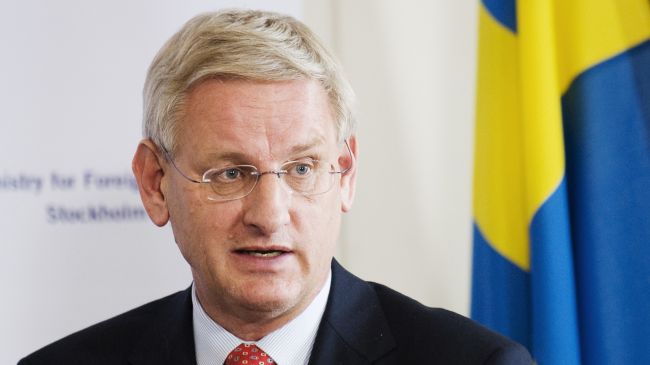Taking North Korea seriously

By Carl Bildt
We are living in dangerous and uncertain times. The United States is engaged in a bizarre and highly polarized presidential election. Its relationship with an increasingly revisionist Russia is undergoing what is essentially a “re-set” in reverse, while Russia’s revisionism is also putting pressure on a Europe already plagued by uncertainty in the wake of the United Kingdom’s vote to leave the European Union. Meanwhile, the Middle East is imploding, with wars in Syria and Yemen fueling a large-scale refugee crisis.
So overwhelmed are world leaders that many have had little time to focus on mounting tensions at the other end of the Eurasian land mass: the divided Korean Peninsula. But while the crisis in Syria may be the most urgent conflict the next US president will have to address, developments in North Korea could well turn out to be the most intractable.
Since North Korea detonated its first nuclear device a decade ago, its activity on this front has been uneven. But the regime has lately stepped up its efforts: two nuclear tests have been carried out this year, with the country’s largest-ever device detonated last month. Tests of long-range missiles have also increased, suggesting that North Korea is slowly but surely progressing toward a deliverable nuclear weapon.
As usual, the international community’s response focuses on sanctions. Indeed, the United Nations Security Council is currently discussing a new resolution in response to last month’s test. Whatever the resolution’s precise contents, it is likely that new sanctions will hurt. The question is whether they will hurt enough.
North Korea’s economy is not exactly in a strong position to withstand much more pressure. In the 1950s, the North’s economy was better off than the South’s; today, it is 40-80 times smaller (depending on who is estimating).
While the North Korean government has loosened its grip on the economy slightly, enabling shadow activities to develop, the country’s prospects remain grim. In human terms, the North Korean regime’s failure to provide for its nearly 25 million inhabitants has been as tragic as it is spectacular.
Even the country’s elite has been feeling the effects of sanctions, reflected in an increase in the number of higher-level defectors over the last year. Of course, political strain has also likely contributed to this trend. In South Korea, some are even considering the possibility of the North Korean regime’s collapse, though others believe that the persistence of harsh repression will continue to ensure a kind of stability.
The North Korean regime has one critical source of support: China. Though China has agreed to tough sanctions, implementation has been lax, and its leaders have shown a distinct reluctance to tighten the screws on their client further. Unlike South Korea, which would welcome a collapse of the regime in Pyongyang (at least in theory), China fears the political and economic consequences.
The fact remains, however, that North Korea’s regime poses a serious threat to stability in the region and perhaps beyond – one that cannot be mitigated without China. While representatives of both US presidential candidates, Hillary Clinton and Donald Trump, have reiterated that the military option must remain on the table – direct US military intervention has always ultimately been rejected. China’s relationship with North Korea no doubt has had some influence over that decision.
So, to mount an effective response to the North Korean nuclear threat, the next US president will need to secure China’s cooperation. That is easier said than done, not least because of America’s recent decision to deploy a Terminal High Altitude Area Defense (THAAD) anti-missile system in South Korea.
Officially, the THAAD system is meant to protect South Korea from the North Korean threat. For the US, its primary purpose is to minimize the risk of South Korea deciding to acquire its own nuclear weapons to counter the North.
For China, however, the system’s advanced X-band radar raises concerns, because it reaches well into Chinese territory. China fears that it could be linked with more advanced missile systems either in Japan or on nearby naval ships, potentially posing a threat to China’s strategic missile forces. These are valid concerns.
The US must reach out to China to explain the nature of the system and discuss measures that might address its fears. One possible approach, proposed by Yoon Young-kwan, a former South Korean foreign minister, would be to tie the existence of the THAAD system explicitly to North Korea’s nuclear program. If the latter is eliminated, the missiles would be removed.
The ultimate goal of talks should be to secure China’s cooperation in developing a comprehensive peace treaty, signed by all regional powers, that normalizes relations with a North Korea that agrees to give up its nuclear weapons and commit to political reform. But the North Korean regime’s past behavior suggests that, even with China on board, the chances of such a Damascene conversion are close to nil.
That is why discussions must also address what might happen if North Korea’s regime suddenly collapses – a possibility, though not imminent, cannot be excluded. In such a scenario, a plan – agreed in advance by the US, China, South Korea, and Japan – that covers border control, refugees, port access, and military operations would need to be in place.
Without China’s buy-in, efforts to curb North Korea’s nuclear ambitions are likely to falter. In that case, the country’s volatile leadership could eventually possess long-range nuclear capabilities – an outcome that must be averted at all costs. The last thing a dangerous and uncertain world needs is more danger and uncertainty.
Copyright: Project Syndicate:Taking North Korea Seriously
---
Follow us on Twitter @AzerNewsAz
